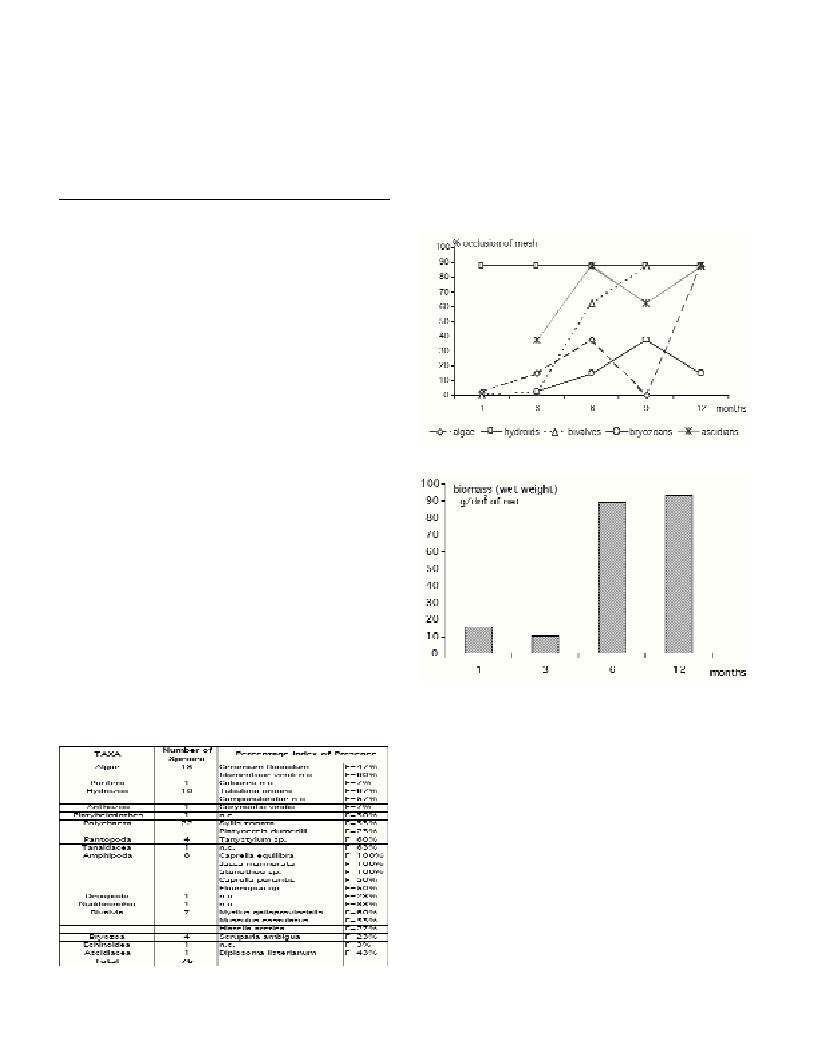MACROFOULING OF MARINE FISH-CAGE NETS
G. Relini
*
, S. Merello
Dip.Te.Ris., Laboratori di Biologia Marina ed Ecologia Animale Universitŕ di GenovaGenova, Italia - * biolmar@unige.it
Abstract
Biofouling of meshes can create a severe problem to mariculture, since netting material is an ideal substrate for many organisms. Some
net-panels were immersed at different time on a fish-cage in the Ligurian Sea for one year. Monthly settlement, development of fouling
community and its biomass were described.
Key-words: fouling, mariculture, fish cages, meshes, Ligurian Sea
Rapp. Comm. int. Mer Médit., 37,2004
543
Introduction
The rapid growth of biofouling on ?oating net cages is a consider-
able problem for mariculture plants, since non-toxic netting material
is an ideal substrate for many organisms (1). The main critical effects
are a reduced water ?ow through the meshes (2, 3) and an increased
load on fish cages. The aim of the paper is to describe settlement and
development of mesh fouling in a marine farm in the Ligurian Sea.
Material and methods
The research has been carried out on the off-shore mariculture farm
of Lavagna (Ligurian Sea). A nylon net (mesh=10 mm side, the same
used for the fish cages) was assembled on 20x24 cm pvc frames to
form “panels”. Panels were suspended vertically on the ?oating cages
at 6 and 12 m depth and removed monthly, every 3 months and after
6, 9, 12 months during a year since August 2001. Composition and
abundance (as Covering Index and number) of fouling organisms
were determined. Wet weight of fouling was measured (g/dm
2
net).
Estimates of the percentage of mesh occlusion have also been done
(4). Altogether 47 panels were examined.
Results and Discussion
Fouling settled down on nets consists of 76 species belonging to 15
taxa of algae and invertebrates (table 1). Polychaetes, algae, hydroids
and molluscs shows the highest number of species. The amphipods
Caprella equilibra, Jassa marmoratae Stenothoesp. have the ma-
ximun percentage index of presence during a year study (100%).
Some species such as hydroid Tubularia croceaand amphipods C.
equilibraand Stenothoesp. settled down on panels every month;
bivalvMytilus galloprovincialissince April and algae since June. The
estimates of mesh occlusion by dominant fouling organisms (panels
after 1,3,6,9 and 12 months immersion) are given in figure 1.
Hydroids and bivalves are the most critical in fact, because of their
quantity, dimension and growth rate, they occlude meshes most of all.
Meshes are heavily fouled already after 6 months of immersion (about
90 g/dm
2
of net) mainly with mussels, hydroids and ascidians (Fig. 2).
References
1-Hodson S. L., Lewis T.E., and Burke C.M., 1997. Biofouling of fish-
cage netting: efficacy and problems of in situcleaning. Aquaculture,152:
77-90.
2-Milne P.H. 1975. Fouling of marine cages, part 1. Fish Farming Int., 2:
15-19.
3-Huguenin J.E., and Ansuini F.J. 1981. Marine biofouling of synthethic
and metallic screens. Oceans 81 Conference Record, Boston: 545-549.
4-Rothwell G.N., and Nash C.E. 1977. Fouling of some netting materials
in semi-tropical waters. Aquaculture in Tropical Oceans– year 01. Report
to the Office of Sea Grant (NOAA) by the Oceanic Institute, Waimanalo,
Hawaii: 2-29, 45-68.
Table 1. Number of taxa and most frequent species found on panels.
Fig. 1. Percentage of mesh occlusion for the main taxa.
Fig. 2. Fouling biomass on panels after 1, 3, 6 and 12 months immer-
sion.

